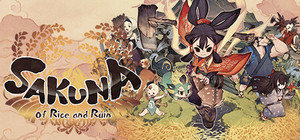Game Review
by Myles Gibbs,Sakuna: Of Rice and Ruin
PC
| Description: |  |
||
In Sakuna: of Rice and Ruin, you play as a Shinto goddess tasked with bringing order to an island of demons, aided only by a ragtag band of humans. Progress through your tale by purging the land of darkness. Expand your territory and hunt for your people at the same time – cutting through hordes of demon beasts with your sickle and hoe. Don't overestimate your strength, though. As a harvest goddess, your power is tied to the crop your land yields. You'll have to become stronger by tending to your rice paddies, planting every single sprout by hand in the pursuit of a harvest fit for a god. |
|||
| Review: | |||
Easily the most unique title I've picked up in recent memory, Sakuna: Of Rice And Ruin is a side-scrolling platform brawler paired with an incredibly in-depth rice-farming sim, complete with JRPG leveling systems. Blending these two components in a compelling and entertaining way is no small feat, but Sakuna often proved to be up to the task. It uses Shinto culture as a backdrop for its tale, and in many ways feels reminiscent of Okami. It's a game that's trying to juggle many opposing concepts: a hack-and-slash and a farming sim, goofy characters and a reverent narrative. This balancing act made it difficult to pick apart what I liked from what I didn't, since more often than not, the two are deeply intertwined.
Right from the get-go, I was charmed by Sakuna's visual style and writing. Designs are all cute and cartoony – it's easy to remember exactly who each character is from the moment they step onto the screen. That said, these cell-shaded caricatures are offset by ornately penciled outlines and parchment texture backgrounds, which grants them a serene quality they would otherwise lose touch with. The writing is well done – comedic when it wants to be – and since most lines are voiced, the script gets plenty of opportunities to shine. You'll also have the option of switching between English and Japanese voices, which presented some interesting decisions on my part. I found that the English dub more easily hit those comedic beats than its Japanese counterpart, which instead excelled more in making certain standout moments shine, especially those relating to cultural insights. Sakuna: Of Rice And Ruin has Shinto culture weaved into its DNA, with both reverence for its teachings and insights into its history scattered throughout the game. When it comes to the question of how Sakuna delivers its tale, I have no complaints; only in its approach to gameplay would some small cracks in its design begin to show.
The exploratory sections are a bit more straightforward. They're snappy, energetic, and fun – for a while. Sakuna navigates stages by using her raiment like a grappling hook, which also aids in solving the platforming puzzles spread throughout the levels that give treasures as rewards. Combat is plentiful during these exploratory sections, and there are demons waiting around almost every turn. They don't usually hamper the pacing very much, since smaller ones can be dispatched easily. The challenge of combat presents itself during sections where Sakuna is forced to fight through multiple waves of enemies. Brawls in this game are all about knocking enemies around – either into environmental hazards or each other. Not only is this by far the quickest way of racking up damage, but enemies are also stunned after being knocked back, thus lessening the threat of Sakuna getting hit by a stray arrow. Enemies can be thrown either at the end of combos, by special attacks, or by grabbing them with Sakuna's raiment. Most of the time, the combat system is pretty entertaining. However, Sakuna also has multiple sudden spikes in difficulty, clearly in the service of preventing the player from proceeding before completing another harvest. The bosses that present these spikes come off as a nuisance, though. None of them have very unique attacks, and every fight boils down to throwing the small enemies at the big one until it falls. The abundance of uninspired boss fights is a big disappointment, turned into an annoyance by the fact that every single time Sakuna dodges an attack she will say either “too slow” or “over here.” These quips quickly outstay their welcome, and make the tough fights even more of a bother to push through. Despite its shortcomings, Sakuna: Of Rice And Ruin is undeniably a quality game. The rice farming simulator alone would have impressed me, but the fact that a challenging platforming brawler is tacked on makes it even more of an enjoyable experience. Certain aspects of its gameplay can definitely become tired or mundane, but by spacing out play sessions, this kind of fatigue can be avoided. |
| Grade: | |||
|
Overall : B+
Graphics : B
Sound/Music : B-
Gameplay : A-
Presentation : A-
+ An inspired art style, good writing, and consistent voice acting make this story an easy one to move through. Combat and farming gameplay are surprisingly fleshed out. |
|||
| discuss this in the forum (7 posts) | | |||